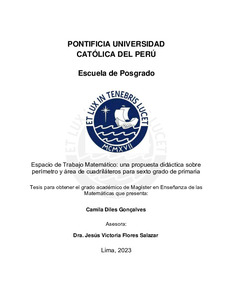| dc.contributor.advisor | Flores Salazar, Jesús Victoria | |
| dc.contributor.author | Diles Gonçalves, Camila | |
| dc.date.accessioned | 2023-07-25T17:44:28Z | |
| dc.date.available | 2023-07-25T17:44:28Z | |
| dc.date.created | 2023 | |
| dc.date.issued | 2023-07-25 | |
| dc.identifier.uri | http://hdl.handle.net/20.500.12404/25447 | |
| dc.description.abstract | Esta investigación tiene por objetivo analizar el trabajo matemático que se promovería en
una propuesta didáctica que se plantea para estudiantes de sexto grado de primaria sobre
perímetro y área de cuadriláteros (específicamente cuadrados y rectángulos) con el uso de
diferentes artefactos. Para el análisis respectivo se tomó en cuenta aspectos teóricos y
metodológicos de la teoría del Espacio de Trabajo Matemático (ETM).
La metodología utilizada es de tipo cualitativa, la cual permite analizar la realidad
describiendo e interpretando los fenómenos a través de los significados, y para esto se realizó
una adaptación del conjunto de fases propuestas por Hernández et al. (2014), donde se toma en
cuenta desde el planteamiento del problema hasta las conclusiones y perspectivas futuras. La
propuesta didáctica incluye tres tareas, las cuales fueron pensadas y construidas a la luz de la
Teoría del Espacio de Trabajo Matemático, con el objetivo de favorecer la utilización de diferentes
artefactos para resolverlas.
Con base en las acciones matemáticas esperadas, el análisis de la propuesta didáctica
busca evidenciar la activación de las tres génesis: génesis semiótica, génesis instrumental y
génesis discursiva, dando énfasis en la activación de la génesis instrumental. Por otro lado,
también se espera la activación de los tres planos verticales, el Semiótico-Instrumental,
Semiótico-Discursivo e Instrumental-Discursivo, siendo el Semiótico-Instrumental el plano
vertical que aparece con más frecuencia. Asimismo, también se hace referencia a la
caracterización de los paradigmas en el dominio de la geometría, entre los cuales, se evidencian
los paradigmas de la Geometría natural (GI) y la Geometría axiomática natural (GII), además la
GI aparece en las tres tareas de la propuesta didáctica. | es_ES |
| dc.description.abstract | This research aims to analyze the mathematical work that would be promoted in a didactic
proposal proposed for sixth-grade students on the perimeter and area of quadrilaterals
(specifically squares and rectangles) using different artifacts. For the respective analysis,
theoretical and methodological aspects of the Mathematical Work Space (MWS) theory were
considered.
The methodology used is of a qualitative type, which allows analyzing reality by describing
and interpreting the phenomena through the meanings, and for this, an adaptation of the set of
phases proposed by Hernández et al. (2014), where it is considered from the problem statement
to the conclusions and future perspectives. The didactic proposal includes three tasks designed
and built-in light of the Mathematical Work Space Theory to favor using different artifacts to solve
them.
Based on the expected mathematical actions, the analysis of the didactic proposal seeks
to demonstrate the activation of the three geneses: semiotic genesis, instrumental genesis, and
discursive genesis, emphasizing the activation of instrumental genesis. On the other hand, the
activation of the three vertical planes is also expected: the Semiotic-Instrumental, Semiotic-
Discursive, and Instrumental-Discursive, with the Semiotic-Instrumental being the vertical plane
that appears most frequently. Likewise, reference is also made to the characterization of the
paradigms in the geometry domain, among which the paradigms of Natural Geometry (GI) and
Natural Axiomatic Geometry (GII) are evident; in addition, GI appears in the three tasks of the
didactic proposal. | es_ES |
| dc.language.iso | spa | es_ES |
| dc.publisher | Pontificia Universidad Católica del Perú | es_ES |
| dc.rights | info:eu-repo/semantics/openAccess | es_ES |
| dc.rights.uri | http://creativecommons.org/licenses/by/2.5/pe/ | * |
| dc.subject | Matemáticas--Estudio y enseñanza (Primaria) | es_ES |
| dc.subject | Geometría--Estudio y enseñanza | es_ES |
| dc.subject | Geometría--Enseñanza con ayuda de computadoras | es_ES |
| dc.title | Espacio de Trabajo Matemático: una propuesta didáctica sobre perímetro y área de cuadriláteros para sexto grado de primaria | es_ES |
| dc.type | info:eu-repo/semantics/masterThesis | es_ES |
| thesis.degree.name | Maestro en Enseñanza de las Matemáticas | es_ES |
| thesis.degree.level | Maestría | es_ES |
| thesis.degree.grantor | Pontificia Universidad Católica del Perú. Escuela de Posgrado | es_ES |
| thesis.degree.discipline | Enseñanza de las Matemáticas | es_ES |
| renati.advisor.dni | 08342853 | |
| renati.advisor.orcid | https://orcid.org/0000-0002-0036-140X | es_ES |
| renati.author.cext | 001644238 | |
| renati.discipline | 199117 | es_ES |
| renati.juror | Neira Fernandez, Veronica | es_ES |
| renati.juror | Flores Salazar, Jesus Victoria | es_ES |
| renati.juror | Garcia Cuellar, Daysi Julissa | es_ES |
| renati.level | https://purl.org/pe-repo/renati/level#maestro | es_ES |
| renati.type | https://purl.org/pe-repo/renati/type#tesis | es_ES |
| dc.publisher.country | PE | es_ES |
| dc.subject.ocde | https://purl.org/pe-repo/ocde/ford#5.03.01 | es_ES |







